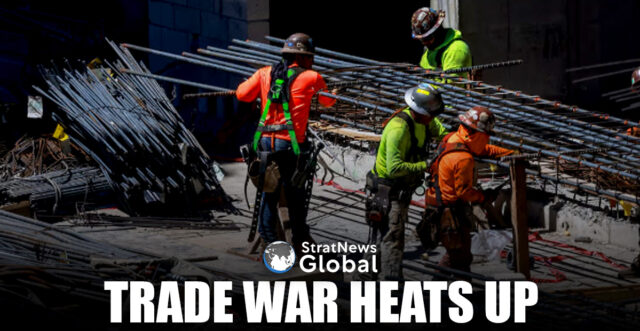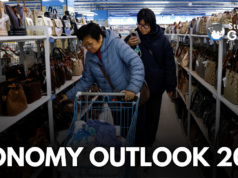U.S. President Donald Trump’s higher tariffs on Canadian steel and aluminium imports took effect Wednesday as previous exemptions, duty-free quotas, and product exclusions expired, intensifying his push to reshape global trade in America’s favour.
Trump‘s action to bulk up protections for American steel and aluminium producers restores effective global tariffs of 25% on all imports of the metals and extends the duties to hundreds of downstream products made from the metals, from nuts and bolts to bulldozer blades and soda cans.
Trump Backs Down
The runup to the tariff deadline came with some drama on Tuesday as Trump threatened Ottawa with doubling the duty to 50% on Canadian steel and aluminium exports to the U.S.
But Trump backed off those plans after Ontario Premier Doug Ford agreed to suspend his province’s decision to impose a 25% surcharge on Canadian electricity exports to the states of Minnesota, Michigan and New York until earlier U.S. tariffs were removed.
Ford said he would fly to Washington on Thursday with Canadian Finance Minister Dominic LeBlanc for talks with Commerce Secretary Howard Lutnick and other Trump officials to discuss revising the U.S.-Mexico-Canada Agreement on trade.
The incident whip-sawed U.S. financial markets already jittery over Trump’s broad tariff offensive, but left unchanged Trump’s original plans to strengthen the Section 232 national security tariffs on steel and aluminum imposed in 2018 during his first term.
‘Win’ For Americans
A White House spokesperson described the U.S. pressure on Canada as a “win” for the American people.
The U.S. Customs and Border Protection agency cut off imports qualifying for duty-free entry under quota arrangements well before the midnight deadline, saying in a bulletin to shippers that quota paperwork needed to be processed by 4:30 p.m. local time on Tuesday at U.S. ports of entry or the full tariffs would be charged.
The move was welcomed by U.S. steel producers as restoring Trump’s original 2018 metals tariffs that had been weakened by numerous country exclusions and quotas and thousands of product-specific exclusions.
“By closing loopholes in the tariff that have been exploited for years, President Trump will again supercharge a steel industry that stands ready to rebuild America,” Steel Manufacturers Association President Philip Bell said in a statement.
“The revised tariff will ensure that steelmakers in America can continue to create new high-paying jobs and make greater investments knowing that they will not be undercut by unfair trade practices,” Bell added.
The countries most affected by the tariffs are Canada, the biggest foreign supplier of steel and aluminium to the U.S., Brazil, Mexico and South Korea, which all have enjoyed some level of exemptions or quotas.
Trade War
The escalation of the U.S.-Canada trade war occurred as Prime Minister Justin Trudeau prepared to hand over power this week to his successor Mark Carney, who won the leadership race of the ruling Liberals last weekend.
On Monday, Carney said he could not speak with Trump until he was sworn in as prime minister. Trump again on social media said he wanted Canada “to become our cherished Fifty-First State.”
Canadian energy minister Jonathan Wilkinson told Reuters that Canada could impose non-tariff measures such as restricting oil exports to the U.S. or levying export duties on minerals, if U.S. tariffs persist.
Canada ships about 4 million barrels of crude to the U.S. per day via pipeline, mainly to Midwest refineries. Canadian tariffs on American ethanol are also an option, he added.
USMCA Trade Deal
Most U.S.-Canada trade remains duty-free under the USMCA trade deal that Trump signed in 2020, but he continues to complain about Canada’s high tariff rates for dairy products.
Ottawa last week won a month’s reprieve for USMCA-compliant exports from Trump’s general 25% tariffs for Canada threatened over fentanyl trafficking.
But in early April, Canada also faced Trump’s reciprocal tariffs aimed at raising U.S. tariffs to match other countries’ rates and counteract non-tariff barriers.
Canada, with ample hydropower resources that have made primary aluminium production more cost-effective than in the U.S., has built a commanding position in the U.S. aluminium market, even as U.S. smelters once revived by Trump’s tariffs have been idled.
China Faces Tariffs
China remains the number two supplier of aluminium and goods made from aluminium, but already faces high tariffs to counteract alleged dumping and subsidies, as well as a new 20% tariff that Trump has imposed over the past month over fentanyl trafficking.
Trump’s hyper-focus on tariffs since taking office in January has rattled investor, consumer and business confidence in ways that economists increasingly worry could cause a recession.
A small business survey on Tuesday showed sentiment weakening for a third straight month, fully eroding a confidence boost following Trump’s November 5 election victory, and a survey of households by the New York Federal Reserve on Monday showed consumers growing more pessimistic about their finances, inflation and the job market.
(With inputs from Reuters)





